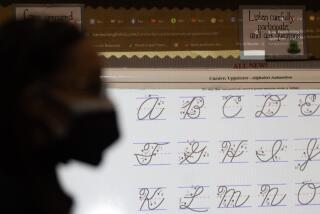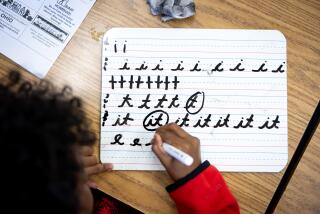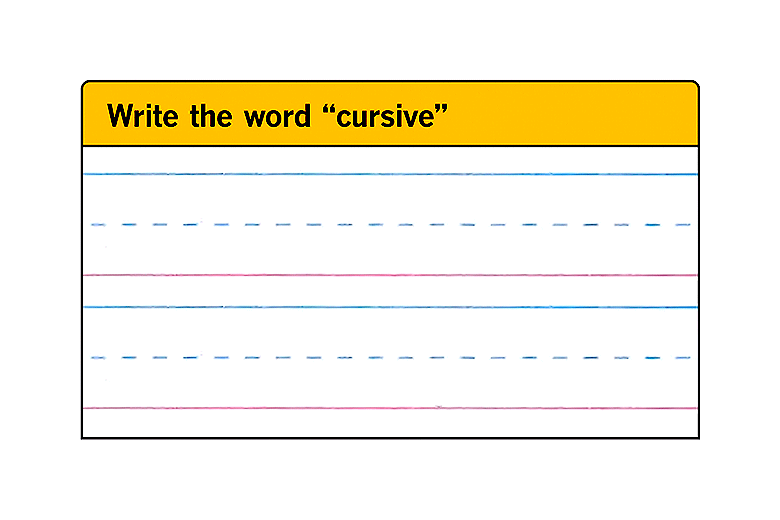Write of Passage?
- Share via
For 25 years, Sally Klapper has spent 20 minutes each day coaching third-graders at the John Thomas Dye School in Los Angeles in the graceful art of cursive writing.
“There are two humps on the camel’s back for M and one hump for N,” she tells her eager pupils. “O is like opening an orange. The only difference between T and F is that you cross the F.”
After months of practice, children make an appointment with her for the ultimate “write of passage”--the cursive test. Those who form all the letters correctly receive a round of applause and permission to pen everything from that day forward in script.
But with fonts and printers replacing pen and paper, this type of dedication is fading fast. Fewer schools are devoting as much time as in the past to teaching and practicing formal cursive lettering. Cursive and printing are in a dead heat--a situation that has experts reading the handwriting on the wall.
“We’re definitely seeing a falloff in full-blown cursive writing and cursive instruction in favor of print script,” says Ed Marshall, president of the American Handwriting Analysis Foundation. “As a result, we’re developing less and less of a mature handwriting style.”
Should children still be spending school hours learning to write clear, proper cursive script? Well, the American Medical Assn. has urged doctors to improve their notorious penmanship to avoid errors in prescriptions. Graphologists are increasingly turning to sketches to evaluate personality. And despite the efforts of specialists at encoding centers across the country, the U.S. Postal Service still winds up with 10 million pieces of indecipherable mail each year.
Our fall from legibility seems to come early in grade school if the pressure is off for penmanship grades. Children who revert to printing or sloppy handwriting may be having difficulty with certain strokes--either as a function of motor and visual skills or insufficient instruction.
Cultural factors are also at work. “Especially with boys, there’s a stigma attached to curlicues and frills,” says Kate Gladstone, who tutors children and adults in Albany, N.Y. “The swoopy, swirling motion of the hand just feels wrong.”
Children who are struggling with their Ps and Qs can benefit from positive reinforcement at home. “Kids will understand the importance of good handwriting when they see their parents writing legibly and hear them remarking on the handwriting of other adults,” Gladstone says. “Parents should also talk about handwriting issues with their child’s teacher.”
To hook children on cursive writing, Gladstone suggests a number of fun activities. Children can practice letters in groups of similar shapes such as a, c, d, g and q. They can write the alphabet from jumbo down to handwriting size on paper taped to the wall. Other hands-down favorites include baking letters out of cookie dough and eating them from the top of the stroke to the last sugary curve, and forming letters out of clay or a jump rope. With help from their parents, children can also re-create old-fashioned writing materials such as quill pens, ink and handmade paper.
Parents may also want to take a closer look at their children’s writing: There may be a whole new slant. The D’Nealian method, developed by Michigan teacher Donald Neal Thurber, has become increasingly popular. This school year, educational publisher Zaner-Bloser dropped the fancy loops and cane stems from its workbooks.
“We found that teachers still wanted to teach handwriting, but they believed it wasn’t being taught well enough,” says Richard Northup, vice president of marketing. “Like riding a bike or ice skating, handwriting is a motor skill that requires practice and someone to teach you.”
The trademark curlicues and loops of standard American cursive evolved from a much simpler Renaissance writing style, one that some penmanship advocates favor. “If you put Leonardo da Vinci or Michelangelo in a classroom today, they’d probably have the same problem as many children do at first and wonder how anyone can read the writing,” Gladstone says.
Twenty years ago, Portland teachers Barbara Getty and Inga Dubay collaborated on a children’s handwriting series based on a Renaissance design. Their basic italic and cursive italic methods have been adopted by Portland and other school districts.
In the Los Angeles Unified School District, cursive writing instruction is part of the third-grade curriculum, says Jerry Herrera, administrator for elementary instruction. The method of writing taught is up to each school, and workbooks are not used. Teachers model the letters and the students practice on lined paper.
“Most teachers are too busy and handwriting is not a high priority,” Getty says. “Many teachers after third grade feel kids should know cursive. That’s like saying they should know how to do math. They need to have that reinforcement.”
The women’s well-attended workshops for adults draw handwritten thank-you notes from business executives and physicians. Why such interest in something supposedly outmoded? “There’s no character to sending an e-mail message, but your whole being is involved in handwriting,” Getty says. “We seem to be so detached these days. Handwriting is still a way to greet the world and express one’s individuality.”
Peggy Lucas is another teacher who thinks cursive is important--so important that she makes up her own handwriting books. Though she admits to being “old-fashioned,” the 15-year teaching veteran is determined that her third-graders at Danube Elementary School in Granada Hills have a firm grasp on handwriting.
“The thrust has been against workbooks, but every teacher I know has to do both the new whole language and drill practice in handwriting, spelling and grammar,” Lucas says. “Kids think handwriting is a grown-up thing. You wouldn’t believe their pride when they look back to their printing at the beginning of the year and see they’ve come such a long way.”
Perhaps it’s not so old-fashioned after all. Writing samples are back in style for standardized grade school testing. College entrance exams have reintroduced the handwritten essay. And several portable computers use fonts based on the users’ own penmanship samples.
But if penmanship isn’t your child’s strong suit, take heart: Beautiful writing and a great personality don’t always go hand-in-hand. “If you look at Albert Schweitzer’s writing, it’s not pretty,” says the American Handwriting Analysis Foundation’s Marshall. “Yet we use his writing as an example of an altruistic, selfless person. If the writing is too pretty, dig deeper.”
(BEGIN TEXT OF INFOBOX / INFOGRAPHIC)
Putting Penmanship to the Test
Penmanship enthusiasts can put their writing to the test in these annual competitions:
* Zaner-Bloser / Parker Pen National Handwriting Contest
Eligible: Students in first to sixth grade whose school uses Zaner-Bloser as its handwriting text.
Entry: Schools can request entry forms by calling (800) 924-9233.
Deadline: March 1, 1997.
* Peterson Directed National Cursive Handwriting Contest
Eligible: Students in third to eighth grade.
Entry: Request an entry form from Peterson Directed Handwriting Co., 315 S. Maple Ave., Greensburg, PA 15601. Enclose a self-addressed, stamped envelope.
Deadline: March 15, 1997.
* American Handwriting Competition
Eligible: Children and adults.
Entry: Request entry information by calling (518) 482-6763.
Deadline: March 1, 1997.






